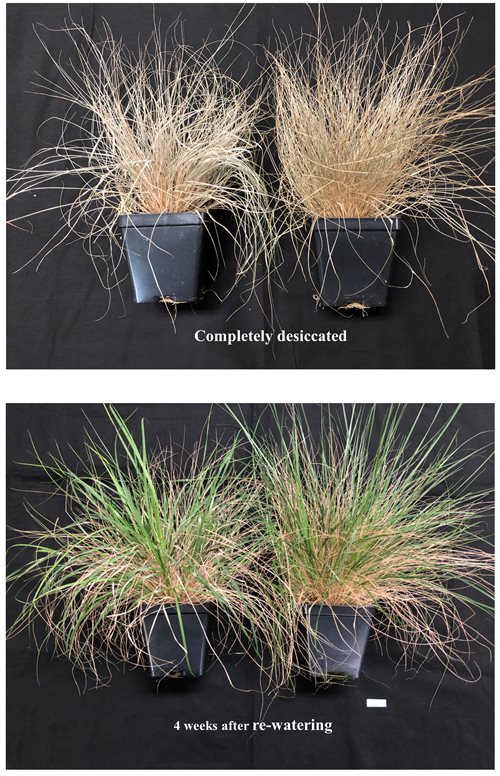Saving injera: Lessons from a teff grain's drought-tolerant cousin
Eragrostis nindensis is known as a resurrection plant: Even after a drought that would kill other grasses, and even if it has shriveled to a dead brown husk, it can rebound and sprout new green shoots when water becomes available.

“It was completely desiccated. Dead,” Shivaiah said. “Nobody thought it would come back. But I started watering and within four weeks … it came back to life.”
Like other researchers in Peter Lundquist’s lab, Shivaiah is interested in how plastoglobules, lipid droplets found in the chloroplast, mediate stress responses. He found that as nindensis stems dry, their plastoglobules increase in size. Nindensis is known to destroy its chlorophyll while drying out, to prevent photo-oxidation. Using lipidomics, Shivaiah observed that crash in chlorophyll level and an increase in smaller lipids and sugars, which he thinks are breakdown products. He suspects that some lipids are converted into sucrose, to stabilize proteins as drier conditions introduce osmotic stress. The adaptation also seems to involve reductions in the level of many plastoglobule proteins.
The findings are preliminary, Shivaiah said. After replicating them to solidify his conclusions about how the plastoglobule changes, he hopes to investigate what differentiates teff plastoglobules from those of E. nindensis.
“Teff is dessication-sensitive. It can tolerate water scarcity for a while, but not as long as E. nindensis,” he said. “Can we do genetic modification to the teff plant to make it as desiccation-tolerant as the nindensis plant?”
You can see Shivaiah's poster presentation here, as part of the Lipids and Membranes poster session, or join a discussion on Tuesday, April 27 at 3:15 p.m. EDT.
Enjoy reading ASBMB Today?
Become a member to receive the print edition four times a year and the digital edition monthly.
Learn moreGet the latest from ASBMB Today
Enter your email address, and we’ll send you a weekly email with recent articles, interviews and more.
Latest in Science
Science highlights or most popular articles

Bacteriophage protein could make queso fresco safer
Researchers characterized the structure and function of PlyP100, a bacteriophage protein that shows promise as a food-safe antimicrobial for preventing Listeria monocytogenes growth in fresh cheeses.

Building the blueprint to block HIV
Wesley Sundquist will present his work on the HIV capsid and revolutionary drug, Lenacapavir, at the ASBMB Annual Meeting, March 7–10, in Maryland.

Gut microbes hijack cancer pathway in high-fat diets
Researchers at the Feinstein Institutes for Medical Research found that a high-fat diet increases ammonia-producing bacteria in the gut microbiome of mice, which in turn disrupts TGF-β signaling and promotes colorectal cancer.

Mapping fentanyl’s cellular footprint
Using a new imaging method, researchers at State University of New York at Buffalo traced fentanyl’s effects inside brain immune cells, revealing how the drug alters lipid droplets, pointing to new paths for addiction diagnostics.

Designing life’s building blocks with AI
Tanja Kortemme, a professor at the University of California, San Francisco, will discuss her research using computational biology to engineer proteins at the 2026 ASBMB Annual Meeting.

Cholesterol as a novel biomarker for Fragile X syndrome
Researchers in Quebec identified lower levels of a brain cholesterol metabolite, 24-hydroxycholesterol, in patients with fragile X syndrome, a finding that could provide a simple blood-based biomarker for understanding and managing the condition.

